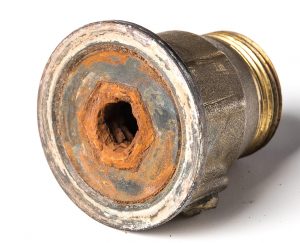
The social housing sector absorbs a hidden cost of millions of pounds every year due to poor water treatment. But just a few small and inexpensive changes to heating system care can deliver significant savings for registered landlords — and improve tenant satisfaction to boot. Craig Mitchell, UK Sales Director at Sentinel, explains.
Correct water treatment prevents corrosion and scale in heating systems, a phenomenon which can otherwise cause boiler breakdowns, early repairs and parts replacements, loss of boiler warranty, lower energy efficiency, poor heating performance (e.g. from cold spots in radiators), and reduced boiler and component life. Astonishingly, most systems — 87%, according to research and testing by major boiler manufacturers — do not have correct water treatment, making corrosion inevitable.
The cost of poor water treatment to housing associations is enormous, with losses felt in asset depreciation, call-backs, and investment in flawed treatment schemes, to name but a few. As heating provision cannot cease, this cost simply has to be absorbed by the social housing provider.
Boiler breakdowns
Of course, it’s not only registered social landlords who are affected by poor water treatment; tenants also suffer. Boiler breakdowns can leave tenants without the basic necessities of heating or hot water, while repairs mean inconvenient and disruptive unplanned engineer visits. Moreover, poor water treatment often results in radiator cold spots, making homes colder. A warm home is associated with better wellbeing, lower energy bills and a higher disposable income, yet the National Housing Federation reports that ‘almost a quarter (23%) of all housing association and local authority tenants are unable to keep their living room warm’.
“…the National Housing Federation reports that ‘almost a quarter (23%) of all housing association and local authority tenants are unable to keep their living room warm’.”
In contrast, best practice water treatment can prevent corrosion-induced problems in heating systems for life. It helps to achieve optimum system longevity (15+ years), performance, and energy efficiency, offering potential lifetime savings of over a quarter of a million pounds per 1,000 boilers (even after the cost of investing in best practice water treatment).
Three step approach
Best practice water treatment comprises three basic steps: ‘clean, protect, maintain’. Cleaning removes contaminants from circulating water and prepares a system for inhibitor (protection). Protection prevents corrosion (and limescale, for systems in hard water areas) and involves dosing a system with a sufficient concentration of high quality and, ideally, boiler manufacturer endorsed inhibitor (and possibly a magnetic vortex filter).
Finally, maintenance is an annual process of checking inhibitor levels, identifying and rectifying causes of insufficient inhibitor levels, if present, and topping up inhibitor if necessary. The filter, if installed, will also be cleaned. The entire system of best practice is estimated to cost less than £13 per year, per boiler — a fraction of the losses incurred with poor water treatment.
Each step of best practice (clean, protect, maintain) is vital and all are mutually dependent. For example, if a heating system is not cleaned properly, the impact of any subsequently dosed inhibitor could be diminished and corrosion is more likely to occur, or, if a heating system is cleaned and protected but not maintained, corrosion will arise if inhibitor levels drop.

System monitoring
The most effective way to ensure best practice is undertaken — thus solving the problem of why only 13% of heating systems are found with correct water treatment — is to implement a monitoring process.
Programmes are available which ensure complete system care by offering free best practice water treatment training to installers and contractors, complete pre-packaged product kits, and online reporting that shows how contractors are performing. Many adopters of such programmes report to have practically eliminated heating repairs and callbacks, saving tens or hundreds of thousands of pounds every year.
While system care programmes are drastically improving the landscape of heating provision in social housing, even better things are afoot. A new innovation, due to launch this year, will help housing associations to benefit from ‘right first time’ water treatment, thus reducing the need for return visits. This is important because currently, cleaning and protection is only confirmed after the job, and typically one in four tested systems are treated incorrectly, resulting in return visits. What’s more, the innovation will help to catch potential problems early, thereby saving money by reducing reactive call out rates to system failures.
A common reaction to system care programmes is ‘what’s the catch?’ There isn’t one; best practice system care is a robust and proven solution for increasing the efficiency of reliable heating provision. Not only does it represent true value for money, it helps registered social landlords to deliver it.








